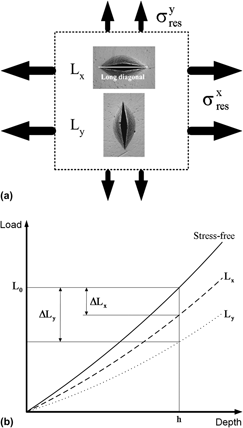Crossref Citations
This article has been cited by the following publications. This list is generated based on data provided by
Crossref.
Groth, B.P.
and
Mann, A.B.
2012.
Identifying changes in residual stress using indentation on machined metallic surfaces.
Materials Letters,
Vol. 89,
Issue. ,
p.
287.
Rickhey, Felix
Lee, Jin Haeng
and
Lee, Hyungyil
2015.
A contact size-independent approach to the estimation of biaxial residual stresses by Knoop indentation.
Materials & Design,
Vol. 84,
Issue. ,
p.
300.
Kim, Jong-hyoung
Xu, Huiwen
Choi, Min-Jae
Heo, Eunju
Kim, Young-Cheon
and
Kwon, Dongil
2018.
Determination of directionality of nonequibiaxial residual stress by nanoindentation testing using a modified Berkovich indenter.
Journal of Materials Research,
Vol. 33,
Issue. 22,
p.
3849.
Peng, Guangjian
Lu, Zhike
Ma, Yi
Feng, Yihui
Huan, Yong
and
Zhang, Taihua
2018.
Spherical indentation method for estimating equibiaxial residual stress and elastic–plastic properties of metals simultaneously.
Journal of Materials Research,
Vol. 33,
Issue. 8,
p.
884.
Zhang, Taihua
Cheng, Wenqiang
Peng, Guangjian
Ma, Yi
Jiang, Weifeng
Hu, Jiangjiang
and
Chen, Heng
2019.
Numerical investigation of spherical indentation on elastic-power-law strain-hardening solids with non-equibiaxial residual stresses.
MRS Communications,
Vol. 9,
Issue. 1,
p.
360.
Peng, Guangjian
Xu, Fenglei
Chen, Jianfeng
Wang, Huadong
Hu, Jiangjiang
and
Zhang, Taihua
2020.
Evaluation of Non-Equibiaxial Residual Stresses in Metallic Materials via Instrumented Spherical Indentation.
Metals,
Vol. 10,
Issue. 4,
p.
440.
Moharrami, R.
and
Sanayei, M.
2020.
Improvement of indentation technique for measuring general biaxial residual stresses in austenitic steels.
Precision Engineering,
Vol. 64,
Issue. ,
p.
220.
Moharrami, R.
and
Sanayei, M.
2020.
Developing a method in measuring residual stress on steel alloys by instrumented indentation technique.
Measurement,
Vol. 158,
Issue. ,
p.
107718.
Moharrami, Rasoul
and
Sanayei, Mahsa
2020.
Numerical study of the effect of yield strain and stress ratio on the measurement accuracy of biaxial residual stress in steels using indentation.
Journal of Materials Research and Technology,
Vol. 9,
Issue. 3,
p.
3950.
Kim, Woojoo
Lee, Kyungyul
Kim, Jong-hyoung
Kim, Young-Cheon
and
Kwon, Dongil
2020.
A Further Study on Knoop Indentation Plastic Deformation for Evaluating Residual Stress.
Korean Journal of Metals and Materials,
Vol. 58,
Issue. 8,
p.
515.
Greco, Alessia
Sgambitterra, Emanuele
and
Furgiuele, Franco
2021.
A new methodology for measuring residual stress using a modified Berkovich nano-indenter.
International Journal of Mechanical Sciences,
Vol. 207,
Issue. ,
p.
106662.
Jeong, Kyeongjae
Lee, Kyungyul
Lee, Siwhan
Kang, Sung-Gyu
Jung, Jinwook
Lee, Hyukjae
Kwak, Nojun
Kwon, Dongil
and
Han, Heung Nam
2022.
Deep learning-based indentation plastometry in anisotropic materials.
International Journal of Plasticity,
Vol. 157,
Issue. ,
p.
103403.
Luo, Sangyu
Huang, Ruizhe
Bai, Haoran
Xu, Baosheng
and
Qu, Zhaoliang
2024.
An indentation-based method for characterization of non-uniform triaxial residual stress in curved thermal barrier coating.
Measurement,
Vol. 232,
Issue. ,
p.
114671.
Han, Zhi
Jiang, Hanyang
Dong, Chenyong
Zhang, Liang
Peng, Guangjian
and
Zhang, Taihua
2025.
Instrumented indentation methods for measurement of residual stresses in thin films/coatings: a review.
Journal of Coatings Technology and Research,
Vol. 22,
Issue. 2,
p.
581.
Moon, Seongin
Hong, Seokmin
Kim, Sung-Woo
Kim, Munsung
and
Lee, Seung-Gun
2025.
Stress–strain curve prediction strategy based on instrumented indentation test using master curve of SS316 stress–strain curve.
Nuclear Engineering and Technology,
Vol. 57,
Issue. 5,
p.
103349.
Moon, Seongin
Hong, Seokmin
Kim, Sung-Woo
Kim, Munsung
and
Lee, Seung-Gun
2025.
Stress–strain curve estimation from load–depth curve of spherical indentation test based on finite element analysis and optimization.
Nuclear Engineering and Technology,
Vol. 57,
Issue. 5,
p.
103326.
Kim, Jong-hyoung
Lee, Kyungyul
Kwon, Dongil
and
Schajer, Gary S.
2025.
Evaluation of Non-equi-biaxial Residual Stresses from the Surface Displacements Around a Single Indentation.
Metals and Materials International,
